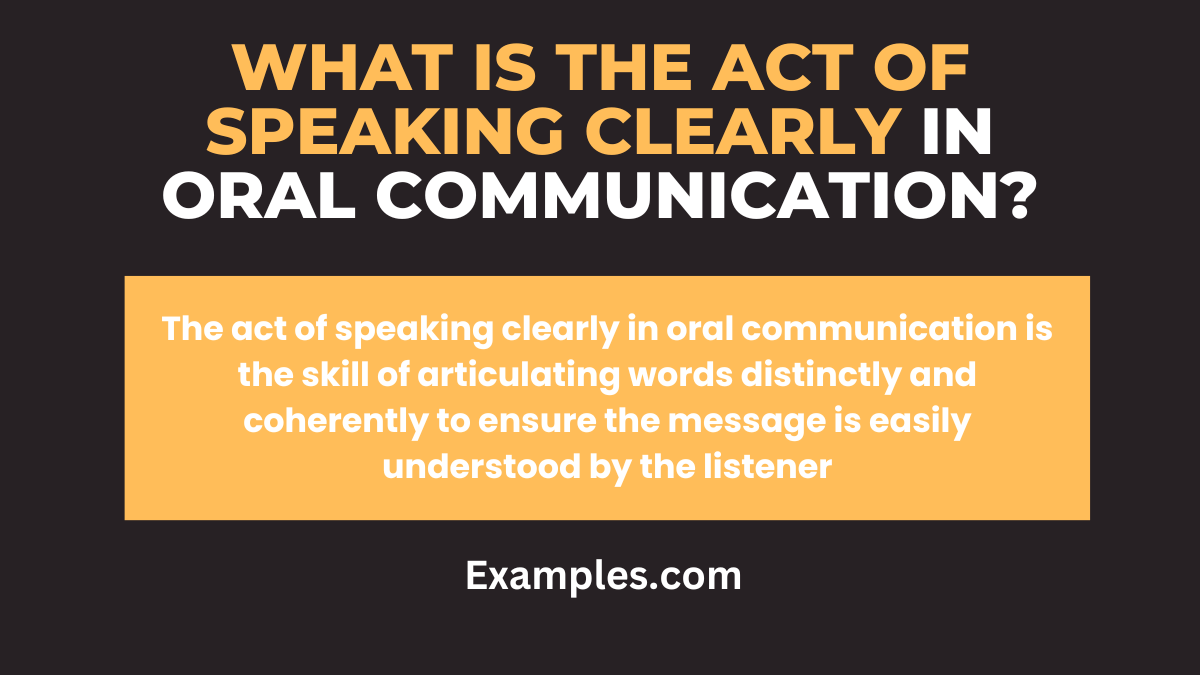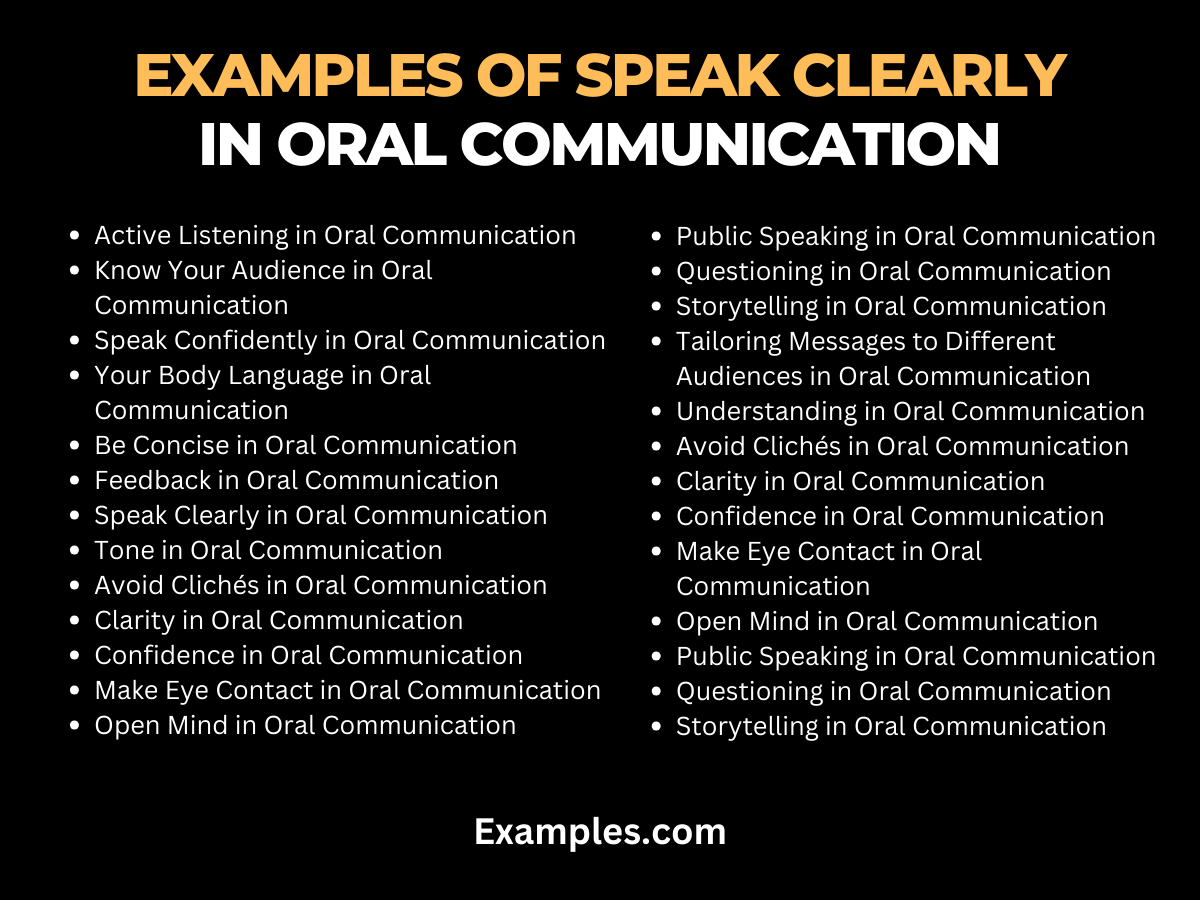29+ Speak Clearly in Oral Communication Examples
Mastering the art of Speak Clearly in Oral Communication is pivotal in the realm of effective personal and professional interactions. This comprehensive guide aims to provide you with essential techniques and insights to enhance the clarity of your speech. Whether it’s in a boardroom, classroom, or casual conversation, the ability to articulate your thoughts clearly is a skill that elevates your communication prowess and ensures your message is conveyed accurately and effectively.
What is the Act of Speaking Clearly in Oral Communication?

Speaking clearly in oral communication involves the precise articulation of words, maintaining an appropriate pace, and using a tone that is easily understandable to the audience. It’s not just about the choice of words but also how they are delivered. Clarity in speech is crucial for effective communication, as it ensures that your message is conveyed without ambiguity or misunderstanding. In professional settings, such as Oral Communication in the Workplace, clear speech is integral for successful interactions and presentations.
30 Examples of Speak Clearly in Oral Communication

To speak clearly in oral communication is crucial for ensuring your message is understood accurately. This skill involves articulating words distinctly, maintaining an appropriate pace, and using a volume that’s audible to your audience. Clarity in speaking is essential in various contexts, from everyday conversations to professional presentations. It not only aids in delivering your message effectively but also demonstrates confidence and respect for your audience. Clear speech is a cornerstone in effective oral communication, enhancing both active listening and engagement.
1. Active Listening in Oral Communication
Active listening in oral communication involves fully engaging with the speaker, understanding their message, and responding thoughtfully. It’s a key skill that enhances mutual understanding and strengthens relationships.
Example: In a team meeting, active listening could be, “I understand you’re suggesting a focus on customer feedback. How do you propose we gather and implement these insights?”
2. Know Your Audience in Oral Communication
Knowing your audience in oral communication means understanding their interests, background, and expectations to tailor your message effectively. This ensures your communication is relevant and impactful.
Example: While presenting to young students, simplify complex topics: “Let’s think of atoms as tiny building blocks that make up everything around us.”
3. Speak Confidently in Oral Communication
Speaking confidently in oral communication involves expressing yourself assertively and with assurance. This instills trust and can influence and persuade your audience.
Example: In a sales pitch, confidently assert, “Our product uniquely solves your needs by offering features that you won’t find elsewhere.”
4. Your Body Language in Oral Communication
Body language in oral communication refers to non-verbal cues like gestures, posture, and facial expressions. It complements your words and can convey confidence and empathy.
Example: In a job interview, maintain eye contact and a straight posture to convey confidence and interest.
5. Be Concise in Oral Communication
Being concise in oral communication means expressing your thoughts clearly and briefly, without unnecessary details. It helps in keeping the audience engaged and ensuring clarity.
Example: When giving instructions, be direct: “Please submit the report by 3 p.m. tomorrow with all the required data.”
6. Feedback in Oral Communication
Feedback in oral communication involves giving constructive responses that can help the speaker improve or understand the impact of their message.
Example: After a presentation, provide specific feedback: “Your explanation of the process was clear, but including more examples could make it more relatable.”
7. Think Before You Speak in Oral Communication
Thinking before speaking in oral communication means considering your words carefully to convey your message effectively and appropriately.
Example: In a sensitive discussion, carefully choose your words: “I understand this is a complex issue; let’s explore potential solutions together.”
8. Speak Clearly in Oral Communication
Speaking clearly in oral communication is about articulating words distinctly and using a suitable pace, ensuring your message is understood.
Example: In a training session, enunciate clearly: “Today, we’ll learn about effective customer engagement techniques.”
9. Tone in Oral Communication
The tone in oral communication is the vocal quality that conveys your attitude or emotion. It’s crucial for expressing sincerity, seriousness, or enthusiasm.
Example: When apologizing, use a sincere tone: “I’m truly sorry for any inconvenience caused. Let’s find a way to resolve this.”
10. Avoid Clichés in Oral Communication
Avoiding clichés in oral communication means using original, specific language instead of overused phrases, making your message more engaging and clear.
Example: Instead of saying, “At the end of the day,” be specific: “Ultimately, our goal is to increase client satisfaction.
11. Clarity in Oral Communication
Clarity in oral communication involves expressing ideas in a straightforward and comprehensible manner. It’s key to ensuring your audience accurately grasps your message.
Example: When explaining a policy change, be clear: “Starting next month, all reports must be submitted by the 5th of each month.”
12. Confidence in Oral Communication

Confidence in oral communication is about expressing yourself with self-assurance and certainty. It helps in persuading and positively influencing your audience.
Example: When leading a project, convey confidence: “I am certain that with our team’s skills, we can meet our project goals efficiently.”
13. Get Rid of Conversation Fillers in Oral Communication
Eliminating conversation fillers like ‘um’ and ‘uh’ in oral communication makes your speech more fluent and professional.
Example: Instead of saying, “Um, our next step is, uh, analyzing the data,” say, “Our next step is analyzing the data.”
14. Make Eye Contact in Oral Communication
Making eye contact in oral communication is crucial for building trust and showing engagement with your audience.
Example: During a sales pitch, maintain eye contact with your audience to show confidence and sincerity in your product.
15. Open Mind in Oral Communication
Having an open mind in oral communication involves being receptive to new ideas and different perspectives, which enhances dialogue and understanding.
Example: In a brainstorming session, encourage openness: “Let’s consider all ideas, no matter how unconventional they may seem.”
16. Public Speaking in Oral Communication

Public speaking in oral communication refers to effectively conveying a message to an audience, requiring clear articulation, engagement, and confidence.
Example: In a public address, use clear language and a confident tone to effectively communicate your message to the audience.
17. Questioning in Oral Communication
Effective questioning in oral communication involves asking clear and purposeful questions to elicit information or encourage deeper thinking and engagement.
Example: In a meeting, ask insightful questions: “How will this strategy directly impact our long-term goals?”
18. Storytelling in Oral Communication
Storytelling in oral communication is a powerful technique to make your message more engaging and memorable by weaving information into a narrative.
Example: To explain a concept, use a relevant story: “Let me tell you about a time when this approach greatly benefited our client.”
19. Tailoring Messages to Different Audiences
Tailoring messages to different audiences in oral communication involves adapting your language, tone, and content to suit the specific audience for relevance and impact.
Example: When speaking to experts, use technical language, but simplify your message for a general audience.
20. Understanding in Oral Communication
Understanding in oral communication refers to accurately interpreting and responding to the messages of others, key for effective dialogue and empathy.
Example: In a negotiation, reflect understanding: “I see your point; let’s explore how we can incorporate your concerns into our plan.
21. Adapting Communication Styles
Adapting communication styles in oral communication involves altering your approach to suit different situations and audiences, ensuring effectiveness and appropriateness.
Example: With a technical team, use specific jargon, but for a general audience, explain the same concepts in simpler terms.
22. Nonverbal Communication Cues
Nonverbal communication cues in oral communication encompass gestures, facial expressions, and posture, which significantly impact how your message is received.
Example: During a presentation, use hand gestures to emphasize points, enhancing the clarity and impact of your message.
23. Empathy in Oral Communication
Empathy in oral communication is about understanding and reflecting the feelings of others, fostering stronger connections and more effective interactions.
Example: When a team member is upset, respond with, “I understand this is challenging; how can I support you?”
24. Cultural Sensitivity in Oral Communication
Cultural sensitivity in oral communication involves being aware and respectful of different cultural backgrounds and expressions in your communication.
Example: In a diverse team, be mindful of cultural nuances in expressions and idioms to ensure inclusivity.
25. Listening for Feedback in Oral Communication
Listening for feedback in oral communication means being open to and actively seeking responses from your audience to refine your message.
Example: After a proposal, ask, “I’d like to hear your thoughts. Is there any aspect of this plan you believe we should alter?”
26. Articulating Complex Ideas Simply
Articulating complex ideas simply in oral communication is the ability to break down complicated concepts into understandable terms for your audience.
Example: Explaining a technical process, use analogies: “Think of this system like a library, organizing and retrieving information efficiently.”
27. Maintaining Professionalism in Speech
Maintaining professionalism in speech is about using respectful, clear, and appropriate language, crucial for effective and courteous communication in professional settings.
Example: In a business meeting, use formal language and a respectful tone: “I appreciate your perspective on this issue.”
28. Using Humor Effectively
Using humor effectively in oral communication can engage and relax your audience, but it must be appropriate and sensitive to the context.
Example: In a team meeting, a light-hearted, work-related joke can break the ice and foster a friendly atmosphere.
29. Negotiation Skills in Oral Communication

Negotiation skills in oral communication involve discussing and reaching mutually beneficial agreements, requiring clear articulation, active listening, and compromise.
Example: During a negotiation, articulate, “Your concerns are valid. Let’s find a middle ground that benefits both parties.”
30. Effective Use of Voice Modulation
Effective use of voice modulation in oral communication means varying your pitch, volume, and pace to enhance message delivery and maintain audience interest.
Example: When emphasizing a key point, modulate your voice to be slightly louder and slower, drawing attention to the significance of the statement.
How to Speak Clearly and Precisely in Oral Communication?
- Pronunciation and Articulation: Focus on pronouncing words correctly and clearly. Practice articulating challenging words to avoid mumbling.
- Pace and Timing: Maintain a steady pace in your speech. Too fast, and you risk being unclear; too slow, and you might lose your audience’s interest.
- Volume and Tone: Use a volume that is audible to your audience, and a tone that is appropriate for the context of your communication.
- Breath Control: Proper breathing techniques can significantly impact the clarity of your speech. Deep breaths support better voice projection and articulation.
- Regular Practice: Regularly practicing speech, perhaps through Public speaking in Oral Communication, can significantly improve clarity over time.
- Feedback and Adjustment: Seek feedback from peers or mentors and adjust your speaking style accordingly. Feedback is a crucial part of the Regulation Control Communication Skills in oral communication.
By incorporating these strategies into your communication repertoire, you will enhance not only your ability to speak clearly but also the overall effectiveness of your oral communication.
Why is it Important to Speak Clearly and Directly in Oral Communication?
- Enhances Understanding: Clear speech ensures that your message is understood accurately, reducing the likelihood of misinterpretation.
- Builds Confidence: When you speak clearly, it reflects your self-assurance and mastery over the subject, enhancing your credibility.
- Facilitates Active Listening: Clear articulation makes it easier for listeners to engage and provide meaningful feedback in oral communication.
- Improves Engagement: Audiences are more likely to stay engaged with a speaker who articulates well.
- Increases Persuasiveness: Clear speech can be more convincing, as it conveys authority and decisiveness.
- Supports Effective Feedback: When you speak clearly, it’s easier to receive and integrate feedback, enhancing the communication process.
- Aids in Conflict Resolution: Clear and direct speech can prevent misunderstandings that might lead to conflicts.
- Promotes Inclusivity: Speaking clearly ensures that even individuals with hearing difficulties or non-native speakers can understand.
Steps to Speak Clearly in Oral Communication
- Practice Articulation: Regularly practice speaking slowly and enunciating your words to improve clarity.
- Mind Your Pace: Avoid speaking too fast; a moderate pace aids in clear communication.
- Use Appropriate Volume: Ensure your voice is loud enough to be heard clearly without shouting.
- Incorporate Pauses: Use pauses effectively to give emphasis and allow your audience to process information.
- Work on Pronunciation: Focus on pronouncing words correctly, especially in professional settings.
- Regular Exercises: Engage in exercises like tongue twisters to improve diction and articulation.
- Record and Review: Record your speech and listen to identify areas for improvement.
- Seek Feedback: Regularly ask for feedback in oral communication to understand how clearly you are being understood.
How to Improve Speaking Clearly in Oral Communication
- Mindful Breathing: Proper breath control can greatly improve the clarity of your speech.
- Continuous Learning: Stay informed about the correct usage of language and terminology.
- Relax Your Vocal Cords: Avoid straining your voice; a relaxed voice is clearer.
- Emphasize Key Words: Stress on important words within your speech for greater clarity.
- Practice Regularly: Consistent practice is key to improving your oral communication skills.
- Monitor Body Language: Ensure your body language in oral communication complements your verbal message.
- Participate in Speaking Activities: Engage in public speaking, debates, or storytelling to enhance clarity.
- Professional Training: Consider professional speech training or workshops for advanced improvement.
In summing up, the ability to speak clearly in oral communication is a pivotal skill that transcends professional and personal boundaries. Clear speech not only enhances understanding but also strengthens connections, establishes credibility, and fosters effective exchange of ideas. It’s a skill that demands practice, awareness, and continuous refinement. Whether in a one-on-one conversation, a team meeting, or a public speaking event, the clarity of your speech plays a crucial role in ensuring your message is conveyed effectively and your voice is heard.
For further enhancement of clear speaking skills, the Toastmasters International website is an invaluable resource. It offers tools and tips for improving public speaking and communication skills, catering to a wide range of audiences. Additionally, The British Council provides extensive material on mastering the English language, which is immensely beneficial for non-native speakers looking to improve their clarity in oral communication



